Reading Comprehension Text and Exercises
The Japanese Kimono
History & Facts
Many nations have traditional styles of dress. These are the country's traditional fashions.
When you think of Japan, one or two images may come to mind. Maybe you think of delicious sushi? Or mountains and temples? Or maybe you think about the traditional Japanese dress (kimono)? Today, we are going to learn about the Japanese kimono.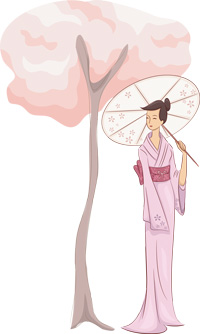
Click Here for Step-by-Step Rules, Stories and Exercises to Practice All English Tenses
Origin
Kimonos came to Japan from China. They were worn underneath clothes as an undergarment. "Kimono" was the Japanese word for clothing. Now however, the word "kimono" refers to one type of Japanese dress.
Kimonos are robes with long sleeves. The sleeves are very wide. Kimonos are also shaped like a "T." People wear a very wide belt with their kimonos. This belt is called an "obi." They are traditionally wrapped around your body from left to right. In fact, only the dead are wrapped right to left! There are different layers to traditional kimonos.
As you will learn, kimonos are a very important part of Japanese history.
Kimonos became popular during the Heian period (the period from 794-1192). Before that, Japanese people wore a different style of clothing. They wore pants and shirts of different materials. During the Heian period, a different type of clothing began being made. People began cutting clothes in straight lines and sewing them together.
This style of making clothes gave makers plenty of freedom. Seamstresses (women whose job is making clothes) didn't have to worry about size or body shape. Kimonos are made in all the same size for women, and all the same size for men. They are folded and tucked to make them fit each person. These kimonos were easy to fold compared to other traditional clothes. And different fabrics made kimonos suitable for all weather. Thick fabrics could be used for winter and thin linen for summer.
Styles
Kimonos were very popular for a long time. As they began getting more popular, people became interested in different colors and fabrics. They matched bright fabrics with seasons. Also, in the past you could match colors to social and political class. By looking at someone's kimono, you could tell what part of society they belonged to.
In the western world and other countries, people wear a lot of accessories. They may wear jewelry like rings and necklaces. People often wear hats and fancy shoes. The Japanese did not dress like this, however. Instead, they expressed their style and taste with the fabric of their kimono. Kimono designers used their fabric as a canvas. Like an artist who paints pictures, people would design very elegant images on their fabric. Some kimonos were even painted with ink!
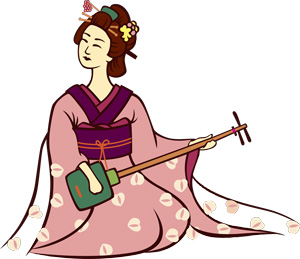
Kimonos for All Walks of Life
Warriors on the battlefield also wore very bright and colorful kimonos. Soldiers paid lots of attention to their dress. They wore extravagant outfits! The color of a warrior's kimono showed what part of the army he belonged to. At one point in time, kimonos involved 25 different layers of fabric! Can you imagine having to put on 25 layers of clothes? Kimonos were taken very seriously and involved lots of work.
Kimonos became more and more popular and the practice of making kimonos became an art form. These traditional dresses became very valuable and parents passed them down to their children as valuable gifts.
While soldiers and government officials dressed in particular colors to show class, normal citizens wore kimonos to show their family. They would put their family crest on their kimonos. During traditional ceremonies, they would wear these kimonos to show which family they belonged to.
Married women had a different style of kimono than single women and mothers also had to teach their daughters how to wear kimonos. Putting a kimono on was a difficult process. Nowadays, there are schools that teach you how to properly wear a kimono.
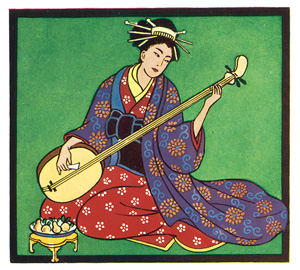
Kimonos Become Less Popular
There are many reasons why the kimono became less popular. Western countries influenced Japan. This made people adopt western style clothing. At one point, people in government were made to wear pants and jackets. They were not allowed to wear kimonos! This is no longer a rule.
Now the most popular fabric to make kimonos with is silk. Silk is an expensive fabric. The cost of the fabric has made kimonos much less popular these days. A kimono could cost you thousands of dollars! And the belt (obi) could be even more expensive. This has made the kimono less popular than in history. Today if you travel to Japan, you will not see as many as you did in the past. However, many tourists and Japanese locals like to dress up in kimonos for fun.
Kimonos in Ceremonies
Kimonos are still worn for traditional ceremonies, as well. You may find Japanese couples getting married wearing kimonos. They are also worn to funerals. The Japanese wear black kimonos to funerals. And men getting married wear black kimonos too. In the past, women wore kimonos while doing traditional arts such as tea ceremonies. They are often worn now to summer festivals.
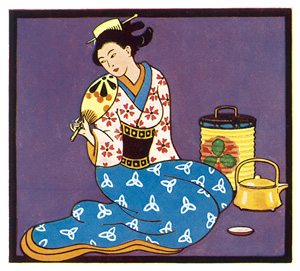
Kimonos Today
The western world has adopted the traditional Japanese kimono. If you go into a clothing store in the United States and ask for a kimono, you will be given a long light fabric robe. It is a popular fashion for young women.
However, traditional kimono fabric designers are considered very important in Japan. Their kimonos sell like an expensive painting. They create unique masterpieces.
While most modern Japanese people do not own kimonos, they are still an important part of Japanese culture. They played a very big part in Japanese history. They are also instantly recognizable as a Japanese icon!
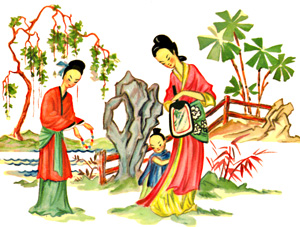
Comprehension Exercises
Vocabulary Questions
- What does "crest" mean?
- a symbol of a family, organization, etc.
- a curved shape similar to the moon
- special ancient decorations
- What does "seamstresses" mean?
- women who make seams
- women who make clothes
- Woman who help deal with stress
- What does "linen" mean?
- lines of color
- material that covers the inner surface of something
- a smooth, strong cloth used to make high-quality fabrics
- What does "icon" mean?
- a traditional way of dressing
- a well-known symbol
- a tourist attraction
- What does "walks of life" mean?
- different levels of society and different types of jobs
- different kinds of sports
- different views people hold based on their backgrounds
Wh Questions
- Where did kimonos originate?
- A. Japan
- B. China
- C. India
- When did kimonos become popular?
- the period from 710-794
- the period from 794-1192
- the period from 1185-1333
- Why did kimonos become less popular?
- Western countries influenced Japan, and this made people adopt western style clothing.
- The cost of the fabric made kimonos too expensive
- Both answers
- Who wears black kimonos?
- people who go to a funeral and men getting married
- couples getting married
- women at tea ceremonies
- How many different layers of fabric did kimonos involved at one point?
- 12
- 25
- 50
Evaluating Statements
- Based on the information in this lesson, which statement is true?
- In Japan people wore a lot of accessories.
- In Japan people didn't like jewelry like rings and necklaces.
- In Japan people expressed their style and taste with the fabric of their kimono.
- Based on the information in this lesson, which statement is false?
- Warriors on the battlefield also wore very bright and colorful kimonos.
- The color of a warrior's kimono showed what part of the army he belonged to.
- Soldiers paid no attention to their dress.
True or False?
- Based on the information in this lesson, is the following statement true or false?
"A kimono could cost you more than a thousand dollars." - true
- false
- Based on the information in this lesson, is the following statement true or false?
"Today if you travel to Japan, you will only see tourists wearing kimonos." - true
- false
Answer Key
1. A | 2. B | 3. C | 4. B | 5. A | 6. B | 7. B | 8. C | 9. A | 10. B | 11. C | 12. C | 13. A | 14. B
Get Updates, Special Offers, and English Resources
Download your FREE GIFT (the first two chapters of
English Short Stories Book and Workbook)
as soon as you join!

By submitting your email, you consent to receiving updates and newsletters from us and to the sharing of your personal data with third parties for the purposes of sending you communications. We will not spam you. You can unsubscribe at any time. For more information, please see our privacy policy.





